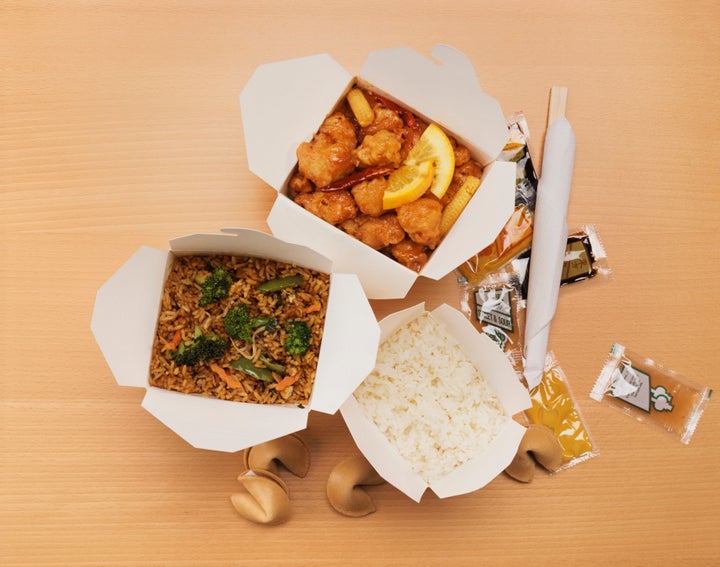A review of Chinese takeaways and supermarket ready meals found many dishes featured “extremely high” salt levels. Beef in black bean sauce dishes were the saltiest on average, while sweet and sour dishes were the least.
Action on Salt, which conducted the review, has called on Public Health England to do more to cut the nation’s salt intake, including enforcing mandatory health warnings on foods containing high amounts of salt.

Takeaways
An analysis of six Chinese takeaway meals purchased from six independent restaurants in London’s Chinatown district found 97% of dishes contained 2g of salt or more - to put that into perspective an adult’s daily salt allowance is 6g, while children should have considerably less.
Over half (58%) contained more than 3g of salt per dish and adding side dishes provided far more salt than the recommended daily limit. The saltiest takeaway main, a beef in black bean sauce and vegetable noodle dish, contained a staggering 11.5g salt.
Action on Salt said there were large variations in the salt content of the same dishes from different restaurants. The saltiest sweet and sour dish contained a staggering 3.4g of salt per dish - the same amount found in 70 Ritz Crackers - while the lowest contained just 1g. It said consuming the lower salt option would cut your salt intake by more than three times in the main dish alone, so it’s worth asking for nutritional information of the dishes you order.
Ready meals
The charity said supermarket Chinese ready meals are also often high in salt, with some rice dishes containing more salt than 11 bags of ready-salted crisps. A review of 141 ready meals found Slimming World’s Chinese Style Banquet Rice to be the saltiest, when ranked by salt per serving, as it contained 4.4g salt per 550g pack.
A Slimming World spokesperson said: “Cooking healthy, filling meals from scratch is – and always will be – at the heart of Slimming World’s Food Optimising healthy eating plan. We encourage our members to fill up on plenty of normal every day foods including lots of vegetables and to reduce the amount of salt and sugar in their diet. At 0.8g/100g of salt, it’s not true to say that the Slimming World meal is the saltiest Chinese dish – there are other Chinese ready meals on the Action on Salt table that are significantly higher in salt per 100g.”
Next in line was Marks and Spencer’s Crispy Sweet and Sour Chicken Banquet with 4.13g salt per 500g pack, providing over two thirds (69%) of an adult’s maximum daily intake. The brand responded in a statement: “As part of our ongoing work to reduce the salt in our recipes, the salt content has already been reduced by 0.25g in our Crispy Sweet & Sour Chicken to 3.88g per portion (down from 4.13g). The packaging is being updated to reflect this and will be in stores shortly. This dish uses authentic ingredients such as soya and oyster sauce which are naturally higher in salt, and all our dishes are clearly nutritionally labelled on the front of packs.”
The least salty meal was Tesco’s Vegetable Chow Mein (0.40g per 120g portion) followed by Sainsbury’s Sweet & Sour Chicken (0.53g per 175g portion).
Sauce
When it comes to dipping in, consumers should also think twice about sauces, Action on Salt said. Some contained excessively high levels of salt, with soy sauces being the saltiest. On average they were five times saltier than seawater.
The charity added that incorporating sides and dipping sauces to your meal could provide you with nearly 4g salt per person alone.
What next?
To mark Salt Awareness Week (12-18 March), Action on Salt has called on Public Health England to take immediate action by setting new salt targets, making front-of-pack labelling mandatory and forcing chain restaurants to put warning labels on high salt dishes.
Sonia Pombo, campaign manager at Action on Salt, said: “Our data shows that food can be easily reformulated with lower levels of salt, so why haven’t all companies acted responsibly?
“The lack of front-of-pack colour coded labelling on branded products makes it incredibly difficult for consumers to make healthier choices and that is simply unacceptable.”
Graham MacGregor, Professor of Cardiovascular Medicine at Queen Mary University of London and Chairman of Action on Salt, added: “Salt is the forgotten killer as it puts up our blood pressure, leading to tens of thousands of unnecessary strokes, heart failure and heart attacks every year. Reducing salt is the most cost effective measure to reduce the number of people dying or suffering from strokes or heart disease. We are now calling on PHE to take immediate action.”